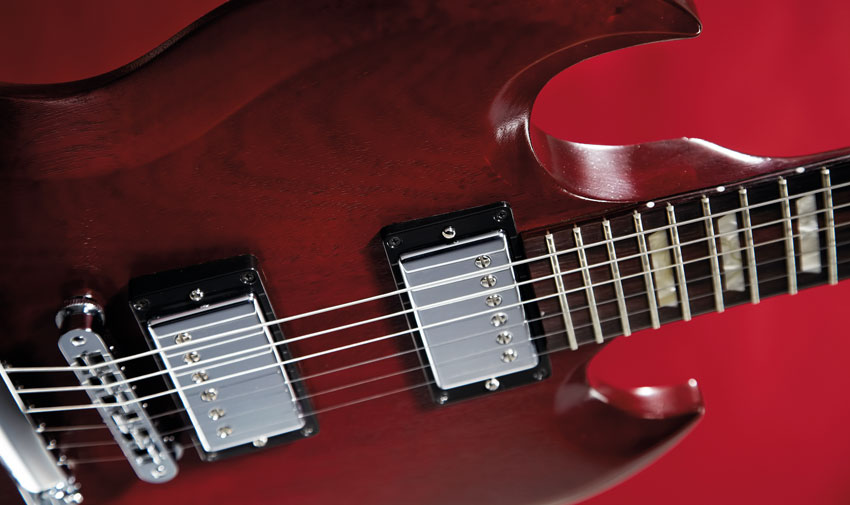MusicRadar Verdict
The truly massive potential of the Min-ETune technology notwithstanding, this guitar sounds very good indeed. Difficult to fault for the price.
Pros
- +
Min-ETune works well and is discreet and easy to use. Performs superbly for the price. Burstbuckers sound impressive.
Cons
- -
Sharp fret ends.
MusicRadar's got your back

Gibson SG '60s Tribute review

Pickups

Min-ETune system
Although 1952 was the year that the Gibson Les Paul first arrived on the market, Gibson has chosen 2013 - the, erm, 61st anniversary of the guitar's introduction and the 98th anniversary of the birth of Lester William Polsfuss - to celebrate the iconic musician's love of guitars with The Year Of Les Paul. What this means, in practice, is a boatload of new versions of the guitars that originally carried his name: the Les Paul and SG.
Of course, Les himself was never a fan of the revised signature model that became the SG, and his name was removed from all production instruments by late 1963. Nevertheless, the 60s and 70s runs of the model are represented by two new SGs, one of which is this striking SG '60s Tribute.
Build
The '60s Tribute may hark back to the SG's early years, but it's been brought bang up-to-date with Gibson's Min-ETune system - the firm's latest take on mechanical self- tuning for electric and acoustic guitars.
"The Min-ETune's weight impact is negligible and visually, it's very discreet, too"
Developed with German company Tronical, the headstock-mounted gears are the next generation of Gibson's 'Robot' technology, and appears on the new Tribute Les Paul and SG models. The whole Min-ETune system - tuners included - sits on a thin black rectanglular plate that covers most of the rear of the peghead. The weight impact is negligible and visually, it's very discreet, too.
You can still tune the pegs by hand (though it's slow going), and operation is reassuringly simple: switch the unit on, strum all open strings and watch their respective LEDs. The LEDs corresponding to the strings that are in tune will turn green. Now, pick any individual strings that have red LED readouts until every string is brought to the desired pitch, after which the unit switches off. Even with wayward tunings, the whole process takes around 15 seconds, and the unit is accurate up to two cents.
The procedure outlined above is for standard tuning, which is barely scratching the surface of what the Min-ETune can do. 12 altered tunings - including DADGAD, open D and open G - are roughly 30 seconds away via the unit's four-way cursor, and you can create your own tunings and store six of those. The Min-ETune is a really big step forward for automatic guitar tuning.
Another feature common to all new Tribute models is what Gibson refers to as its 'Vintage Gloss' nitrocellulose finish. In the flesh, this is a pleasing off-the-gun thin satin nitro, complete with grain sinkage, that hasn't been cut back or buffed to a mirror-like sheen. Straight out of the gigbag, the guitar feels more akin to a well-used workhorse than the traditional gloss and, for this writer at least, it has an immediate pick-me-up-and-play-me appeal.
Want all the hottest music and gear news, reviews, deals, features and more, direct to your inbox? Sign up here.
In short, the '60s Tribute SGs is a joy. 24 frets isn't exactly a specification that's particularly rooted in the '60s, but the uniquely generous upper-fret access afforded by the SG's design does mean that you have easy access to the full two octaves. As such, it's a slide player's playground, and fans of Derek Trucks will no doubt find much to love about this '60s model in Heritage Cherry, which does look magnificent in satin.
Ordinarily, we'd have baulked at the idea of a Gibson SG without a scratchplate, but this guitar gets away with it. Light weight, easy access, great neck profile, seriously raunchy acoustic tones... we'd be mad not to plug it in.
Sounds
"The refined and articulate BurstBuckers lend a touch of genuine class"
The '60s Tribute is the connoisseur's choice of the new batch of affordable Gibsons, with the refined and articulate BurstBuckers lending a touch of genuine class to a guitar that punches quite far above its price division in sonic terms. Clean or dirty, it's difficult to put down. It's the guitar that everyone in the office wanted to take home.
The truly massive potential of the Min-ETune technology notwithstanding, the guitar sounds very good indeed, and with just a touch of careful attention applied to the fretwork, it would be difficult to fault for the price, especially given the extra finesse of its BurstBucker pickups.
But the real talking point here is the Min-ETune functionality. Some players will sneer at the mere idea, of course, but anyone who does a lot of studio recording or uses multiple tunings in a live scenario should check it out without delay. For once, we find ourselves writing about new guitar technology that just seems to work and doesn't look like a dog's dinner in the process. Bravo Gibson and Tronical.
Chris Vinnicombe worked with us here on the MusicRadar team from the site's initial launch way back in 2007, and also contributed to Guitarist magazine as Features Editor until 2014, as well as Total Guitar magazine, amongst others. These days he can be found at Gibson Guitars, where he is editor-in-chief.